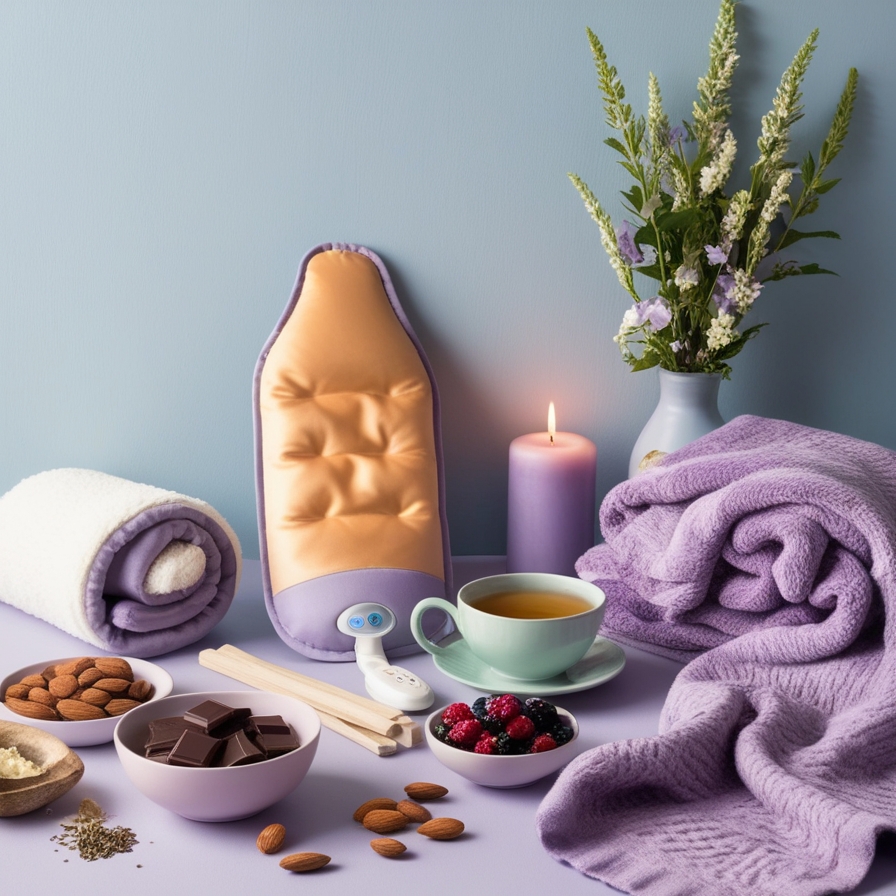Menstrual cramps, also known as dysmenorrhea, are a common issue many women face during their periods, these cramps occur when the uterus contracts to shed its lining, and while they can be mild for some, others may experience intense pain that interferes with their daily activities, the good news is that there are several effective and natural ways to ease period cramps and improve comfort during that time of the month.
1. Apply Heat Therapy
- How It Helps.
Heat relaxes the muscles of the uterus and improves blood flow, reducing the severity of cramps. - What to Do.
- Use a heating pad or hot water bottle on your lower abdomen.
- Take a warm bath to soothe your body.
- Try heat patches for on-the-go relief.
2. Stay Hydrated
- How It Helps.
Dehydration can worsen bloating, which may make cramps feel more intense, drinking enough water can reduce water retention and ease discomfort. - What to Do.
- Aim for 8–10 glasses of water daily.
- Add lemon or cucumber slices to make water more appealing.
- Avoid caffeine and alcohol, as they can dehydrate you.
3. Exercise Regularly
- How It Helps.
Physical activity increases blood circulation and releases endorphins, the body’s natural painkillers, which help reduce cramp intensity. - What to Do.
- Try light exercises like walking, yoga, or stretching.
- Focus on poses like child’s pose or cobra pose to relieve tension in the lower abdomen.
- Avoid high-intensity workouts if cramps are severe.
4. Eat Anti-Inflammatory Foods
- How It Helps.
Certain foods can help reduce inflammation and soothe period cramps. - What to Eat.
- Fruits and Vegetables. Leafy greens, berries, and oranges.
- Healthy Fats. Avocados, nuts, and seeds.
- Herbal Teas. Ginger and chamomile tea have anti-inflammatory and muscle-relaxing properties.
- Omega-3 Fatty Acids. Salmon, mackerel, and flaxseeds.
- What to Avoid.
Limit salty, sugary, and processed foods as they can worsen bloating and inflammation.
5. Practice Relaxation Techniques
- How It Helps.
Stress and tension can amplify pain, relaxation techniques help reduce stress hormones and relax uterine muscles. - What to Do.
- Try deep breathing exercises to calm your nervous system.
- Practice meditation or mindfulness to distract from the pain.
- Use aromatherapy with essential oils like lavender or eucalyptus for relaxation.
6. Massage Your Abdomen
- How It Helps.
Massaging your lower abdomen can reduce muscle tension and improve blood flow. - What to Do.
- Use circular motions with your fingertips.
- Apply essential oils like lavender, clary sage, or peppermint mixed with a carrier oil for added relief.
7. Take Over-the-Counter Pain Relievers
- How It Helps.
Medications like ibuprofen or naproxen reduce the production of prostaglandins, which cause cramps. - What to Do.
- Take the medication at the first sign of cramps for maximum effectiveness.
- Always follow the recommended dosage and consult a doctor if you have any health concerns.
8. Try Herbal Remedies
- How It Helps.
Certain herbs have been traditionally used to relieve menstrual cramps. - What to Use.
- Ginger Tea. Reduces inflammation and relieves nausea.
- Chamomile Tea. Calms the mind and soothes muscles.
- Cinnamon. Has antispasmodic and anti-inflammatory properties, sprinkle it on your food or add it to tea.
9. Maintain a Healthy Lifestyle
- How It Helps.
Regular healthy habits can help reduce the frequency and intensity of period cramps over time. - What to Do.
- Maintain a balanced diet rich in whole grains, lean proteins, and fresh produce.
- Engage in regular physical activity to regulate hormones and improve blood flow.
- Aim for 7–8 hours of sleep each night to allow your body to recover and reduce stress.
10. When to Seek Medical Help
While period cramps are common, severe or debilitating pain may indicate an underlying condition, such as.
- Endometriosis. Tissue similar to the uterine lining grows outside the uterus, causing intense pain.
- Fibroids. Non-cancerous growths in the uterus can lead to heavy periods and cramps.
- Pelvic Inflammatory Disease (PID) Infection in the reproductive organs can cause severe discomfort.
What to Do.
If your period cramps are unmanageable or accompanied by other symptoms like heavy bleeding, irregular periods, or pain between cycles, consult a healthcare provider for further evaluation.
Final Thoughts
Menstrual cramps can be challenging, but they don’t have to disrupt your life, by incorporating natural remedies like heat therapy, a healthy diet, and relaxation techniques, you can effectively reduce period pain and improve your overall well-being. remember, every woman’s body is unique, so it’s essential to find the methods that work best for you.
Feel free to share this guide with your readers to empower them to take control of their menstrual health.

